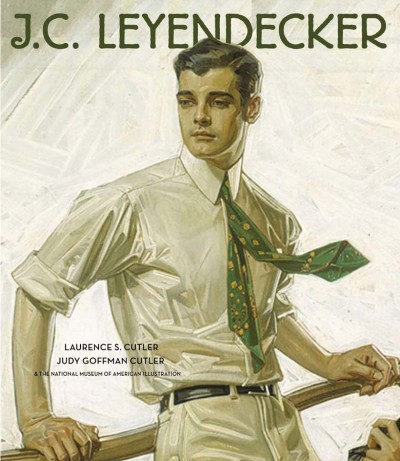 J.C. Leyendecker
J.C. Leyendecker
by Laurence and Judy Cutler
Abrams
256 pages (illustrated), $50.
AN EXCEPTIONALLY BEAUTIFUL volume to grace the coffee table of any art lover, J. C. Leyendecker is the second major study of perhaps the most successful illustrator, or imagist, as he’s referred to by the authors, of the first half of the 20th century. Michael Schau’s 1974 Watson-Guptill publication of the same name is now a collector’s item, though this new Abrams edition by Laurence and Judy Cutler is more lavishly illustrated and more forthright about the artist’s life as a gay man, gathered from what little is known of this highly private individual.
Joseph Christian Leyendecker (1874–1951) was a genius about advertising. He virtually invented the concept of branding and developed ad campaigns for such mega-companies as Ivory Soap and Kellogg’s cereals. He’s probably best known for his Arrow Collar campaign for Cluett, Peabody & Co. and for his illustrations for Kuppenheimer & Co. menswear. In addition to his ad art, and just as prolifically, he created covers for many national magazines, among them Collier’s, Century, Scribner’s, Vanity Fair, Woman’s Home Companion, Ladies Home Journal, and scores of others.
Leyendecker’s celebrated covers for The Saturday Evening Post spanned 44 years; he created 322 of them, more than any other illustrator. Leyendecker was deeply revered by the budding artist Norman Rockwell (1894-1978), who would go on to paint exactly 321 covers for the Post, stopping one shy of his idol out of respect. Nevertheless, according to the Cutlers, Rockwell also stole clients from Leyendecker, as well as artistic techniques, image themes, ideas, and interpretations. He even moved to New Rochelle, New York, to be closer to the elder artist, so consumed was he by Leyendecker, his art, and his success. The influence of Leyendecker on Rockwell’s work can be clearly seen by a casual riffling through this book.
Born in Germany, then immigrating to Chicago with his family at the age of eight, Leyendecker developed his artistic techniques from early schooling at the Art Institute of Chicago, and later at the Académie Julian and the Colarossi in Paris. Among his friends while abroad was Alphonse Mucha (of Art Nouveau posters fame), but he also became acquainted with other artists who would become world famous, such as Gauguin and his circle. The artist’s younger brother Frank—Franz X. Leyendecker (1879–1924)—had accompanied him to school on the continent, also studying art and hoping to succeed as an illustrator.
Upon returning to Chicago from Paris, brothers Joseph and Frank opened a studio together, and after two years of increasing recognition and steady work from magazine commissions, the pair moved to New York and again set up a joint studio, where success came to both. Back in Paris, Frank—who was also gay—had succumbed to the bohemian indulgences of alcohol, drugs, smoking, and probably promiscuity, which would forever undermine his physical condition and the high level of success achieved by his brother. In 1903, while Joe was away from the New York studio, an extraordinarily handsome young man appeared looking for work as a model. Frank hired him, and when Joe returned and saw the then seventeen-year-old Charles Beach, “he could not believe his eyes: his dreams had been realized,” in the authors’ words. The two became inseparable and remained together for 48 years. Joe was twelve years Beach’s senior.
Beach was to become the Arrow Collar man when Joe began developing his ad campaign for Cluett, Peabody & Co. two years later. The painter’s “look” in ad art evolved into an immediately recognizable style, influenced by Impressionist brushwork, cleanly focused compositions that showcased the clothing with a casual but elegant sensuality that stroked a universal sexual nerve. In the Cutlers’ words: “Charles Beach was not only Joe’s idea of the perfect man. Leyendecker’s advertisements for Arrow Collars and Arrow Shirts made him the paradigm for a nation. He was, in fact, the first American ‘culture hero.’ Few, if any fans even realized that their lofty ideal man was not only a homosexual but a kept man, the live-in lover of the famed artist who thrust himself into such an exalted status.”

Leyendecker’s men epitomized elegance and idealized American masculinity, and though he often included people of color in his magazine covers (albeit usually in stereotypical positions), they seldom appear in his menswear ad paintings. The artist’s tastes—and those of the readership of these magazines—were biased toward glamorous, white, upper-class and upper-middle-class American standards of the era.
As a gay artist, whether consciously or not, Leyendecker insinuated homoerotic desire into many of his menswear ads. Consider for example the 1912 illustration for Arrow Collars entitled “Two Men on Sofa.” The pose taken by these men suggests a proposal of some kind, with the fellow on the left offering his empty glove (his “hand in marriage” perhaps?) to the man on the right, whose left index finger is inserted between the pages of a red book he holds between his spread legs (red neckties were a clue to homosexuality in the early-to-mid-20th century).
Typically, Leyendecker’s men sport handsome features, luxuriant eyelashes, and exceptional poise, posture, and athletically proportioned bodies showing beneath their clothing. And yet these idealized images of men provoked no homophobic outrage. The cultural standards of the day allowed for men to engage in homosocial relationships that included a measure of physical and emotional expressiveness—within fairly strict limits, of course—of a kind that we no long have. Leyendecker’s approach to men’s fashion reflected the relatively relaxed attitudes of the 1920’s and 30’s, which were a change from his more Victorian predecessors. The Arrow Collar campaign was enormously successful, giving the artist and his lover a lavish lifestyle and private life.
In nearly equal measures, J. C. Leyendecker offers a fine balance of biography and artistic development. Various appendices, a chronology, annotated notes, and a bibliography provide additional materials of value for dedicated fans and aficionados. The authors, designers, and publisher have honored their well-deserving subject with this handsome book.







